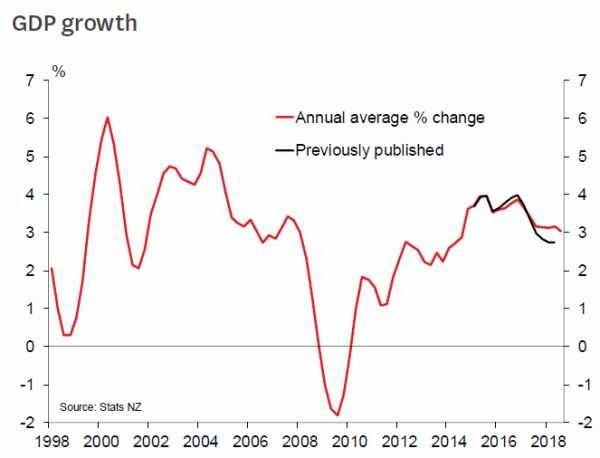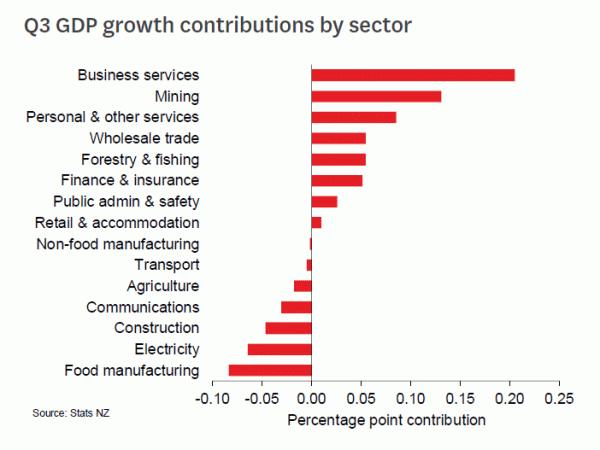- GDP rose by 0.3% in the September quarter, less than forecast.
- The soft September result was partly payback for the 1% gain in June, which benefited from some one-off factors.
- Revisions to the historic GDP data reveal that the economy has retained more momentum than previously thought, with annual growth running at around 3%.
- Today’s results don’t alter our near-term outlook for the economy.
We were braced for some payback after the 1% surge in June quarter GDP, which was supported by some nonrepeating factors. As it turns out, the September quarter result was softer than anyone expected. GDP rose by just 0.3%, the smallest quarterly gain in almost five years. On a more positive note, Stats NZ’s annual round of GDP revisions has once again painted a more upbeat picture of recent history. GDP growth was revised down slightly for 2016, but was revised up quite a bit over 2017. (It’s worth noting that we highlighted the potential for both of these revisions as far back as our June Economic Overview.) The result is that the slowdown in growth over the last couple of years has been more modest than previously thought, and that the economy still has reasonable momentum, with growth tracking at around 3% a year.
On balance, though, it was still a disappointing GDP report, and the market reaction on the day is understandable – the New Zealand dollar is down about 20 points to 0.6780, and swap rates fell by about four basis points. Despite the upward revisions to historic GDP, the Reserve Bank will probably still conclude that the economy is not running as close to its full potential as expected, and that inflation pressures may be slower to build. Our view remains that the RBNZ will stay its course for a long time, with no hike in the OCR until late 2020.
Looking ahead, the details of today’s report don’t give us obvious cause to change our outlook. We continue to expect growth to pick up a little in 2019, supported by faster growth in government spending and a slightly more buoyant housing market. However, this pickup in growth is likely to be a short-lived one, with population growth slowing and the level of construction peaking.
Details
The production measure of GDP rose by 0.3% in the September quarter, compared to a 1.0% gain in June and a 0.9% rise in the same quarter a year ago. We were forecasting a 0.5% increase, while market forecasts were clustered around 0.5-0.6% and the Reserve Bank forecast a 0.7% rise in its November Monetary Policy Statement. As expected, some of the big positives in the June quarter proved to be one-offs. Agricultural output, and consequently food manufacturing, were down in seasonally adjusted terms, following an abnormally strong June quarter. Electricity generation was hit by both lower demand and low hydro lake levels. And tourist spending reversed after a sharp June quarter rise, which appears to have been felt most keenly in the hospitality sector.
On the positive side, there was continued solid growth in areas such as business services, forestry, wholesale trade and healthcare. Retail spending, outside of hospitality, saw a solid 0.8% gain.
Do the surprises relative to our forecast give us cause for concern about the near-term outlook? Again, it’s likely that temporary factors are playing a role. One of the reasons for the shortfall in our forecast was that mining output didn’t recover by as much as we assumed, reflecting ongoing disruptions at the Pohokura offshore oil field. But this simply means that the rebound will carry on into subsequent quarters.
Another weak point was construction. Housing and commercial construction rose as expected, but there was a sharp drop in non-building activity, for which there is very little data available. Roading repairs after the Kaikoura earthquake are now winding down; once they’re complete, they won’t be an ongoing drag on the pace of growth.
Central government services rose by 0.7% for the quarter. But we were expecting a substantially larger gain, given that government personnel spending – the main indicator for this sector – surged during the quarter. The implication is that much of the increase has been treated as nominal rather than real – that is, higher pay rates rather than more services provided.
The final surprise for us was a 0.9% decline in the IT and telecommunications sector. But this is a dynamic field where the level of activity is difficult to measure, and its growth is often only revealed in subsequent data revisions. The expenditure measure of GDP is more volatile and considered to be less reliable on a quarterly basis, but in this case was in line with our 0.5% forecast. Household spending grew by 1%, the same as in the previous quarter reinforcing the sense that the softness in the retail trade survey was due to lower spending by tourists rather than locals. The Government’s Families Package came into effect at the start of the September quarter, and the extra money in many households’ pockets is likely to have outweighed the rise in petrol prices.
Business investment in plant and machinery fell by 1.6% for the quarter, though it’s still up almost 4% on a year earlier. Subsequent data on imports of machinery suggest that we’ll see a pickup in investment in the December quarter. Exports were mixed, with a 2.2% rise in goods but a 4.2% fall in services. The latter followed a 4.4% gain in the June quarter, reflecting the volatility in tourist spending. Imports were flat for the quarter.
Our forecast for December quarter GDP growth remains at 0.8%. Consumers are becoming a little more confident as petrol prices have pulled back from their highs, business investment us looking stronger, mining output should continue to recover, and milk production is running ahead of recent years as it enters the peak of the season.
















